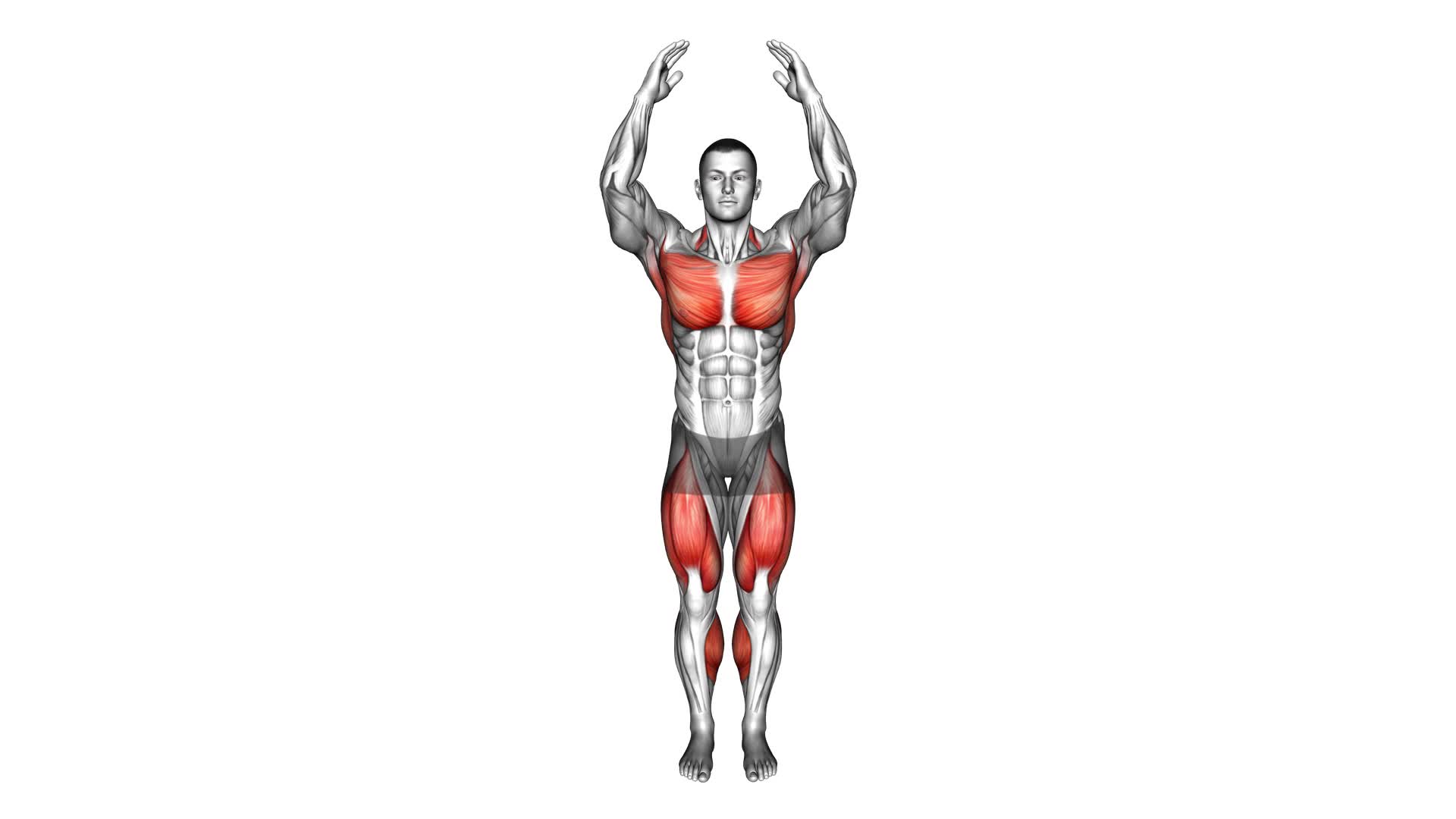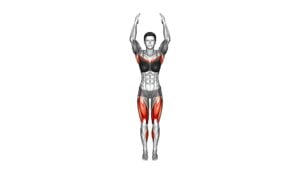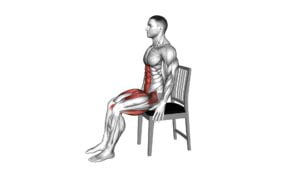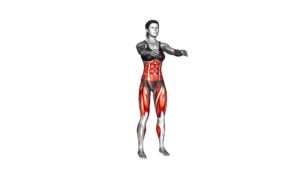Standing March With Shoulders Extension (Male) – Video Exercise Guide & Tips

In this video exercise guide, you'll learn how to perform the Standing March with Shoulders Extension. This exercise offers numerous benefits for your upper body strength and stability.
Watch This Exercise Video
All you need is your own body and a little space to get started. Follow along with the video to ensure proper form and technique. You'll also discover modifications and variations to challenge yourself.
Get ready to incorporate this effective exercise into your workout routine.
Key Takeaways
- The Standing March With Shoulders Extension exercise improves posture and promotes proper alignment.
- It engages core muscles for spinal stabilization and increases core stability.
- This exercise strengthens upper back, shoulders, and arms, as well as leg muscles.
- It enhances shoulder mobility and cardiovascular fitness, while effectively burning calories.
Benefits of the Standing March With Shoulders Extension
The standing march with shoulders extension offers you a range of benefits to improve your upper body strength and shoulder mobility. One of the key benefits is improved posture. As you perform this exercise, you engage your core muscles, which helps to stabilize your spine and promote proper alignment. This can lead to better posture both during the exercise and throughout your daily activities.
Another benefit of the standing march with shoulders extension is enhanced shoulder strength. As you raise your arms and extend your shoulders, you're actively working the muscles in your upper back, shoulders, and arms. This can help to strengthen these muscles, leading to improved overall shoulder strength and stability.
By regularly incorporating the standing march with shoulders extension into your workout routine, you can reap these benefits and more. Not only will you see improvements in your posture and shoulder strength, but you may also experience increased range of motion in your shoulders and improved upper body endurance.
Remember to start with lighter weights and gradually increase the resistance as you become more comfortable with the exercise. Proper form and technique are crucial to maximize the benefits and prevent injury.
Equipment Needed for the Exercise
To perform the standing march with shoulders extension, you'll need a set of dumbbells or resistance bands. These pieces of equipment will provide the necessary resistance to challenge your muscles during the exercise. Dumbbells come in various weights, allowing you to choose the appropriate level of difficulty based on your fitness level. Resistance bands, on the other hand, offer a different type of resistance that can be adjusted by using different bands with varying levels of tension.
In addition to the equipment needed, there are also variations and modifications you can make to the exercise. For example, if you don't have access to dumbbells or resistance bands, you can use household items like water bottles or cans as makeshift weights. Alternatively, you can perform the exercise without any added resistance, focusing on proper form and control.
To add variety to your workout routine, you can also try different variations of the standing march with shoulders extension. For instance, you can perform the exercise while standing on one leg to engage your core muscles and improve balance. Another variation is to perform the exercise in a seated position, using a stability ball or chair for support.
Remember to always consult with a qualified fitness professional before attempting any new exercise, especially if you have any pre-existing medical conditions or injuries.
Proper Form and Technique for Performing the Exercise
To perform the standing march with shoulders extension, you'll need to maintain proper form and technique throughout the exercise. This will ensure that you engage the correct muscles and minimize the risk of injury.
One common mistake is to let your shoulders hunch or round forward during the exercise. To avoid this, keep your shoulders pulled back and down, maintaining a tall and upright posture. This will help to activate the muscles of the upper back, particularly the rhomboids and middle trapezius.
Another common mistake is to lift your knees too high during the marching motion. To properly target the muscles of the lower body, keep your knee lifts controlled and parallel to the ground. Avoid excessive swinging or thrusting motions, as this can put unnecessary strain on your hips and lower back.
The standing march with shoulders extension primarily targets the hip flexors, glutes, and core muscles. By lifting your knee and extending your shoulder at the same time, you engage these muscles in a coordinated manner. Focus on maintaining a strong and stable core throughout the exercise, as this will help to improve your balance and stability.
Modifications and Variations to Challenge Yourself
To challenge yourself and further enhance your workout, try incorporating modifications and variations into the standing march with shoulders extension exercise.
By making modifications to the exercise, you can target different muscle groups and increase the intensity of your workout. One modification you can try is to add resistance bands or weights to your wrists or ankles. This will add extra resistance and make the exercise more challenging.
Another modification is to increase the speed of your leg movements. Instead of marching slowly, try marching at a faster pace to increase the cardiovascular benefits of the exercise.
To progress the exercise even further, you can try incorporating knee lifts or high knees into the march. This will engage your core muscles and increase the difficulty of the exercise.
Additionally, you can also try performing the exercise on an unstable surface, such as a balance board or a foam pad. This will challenge your balance and stability, further enhancing the workout.
Remember to always listen to your body and choose modifications that are appropriate for your fitness level.
Tips for Incorporating the Exercise Into Your Workout Routine
To incorporate the standing march with shoulders extension exercise into your workout routine, consider the following tips.
First, it's important to determine the appropriate amount of cardio you want to incorporate into your workout. This exercise can be a great addition to your cardio routine, as it engages multiple muscle groups and increases your heart rate.
Start by performing the exercise for a set amount of time, such as 30 seconds, and gradually increase the duration as your fitness level improves.
To further increase the intensity of the exercise, you can add weights to your hands or ankles. This will challenge your muscles and elevate your heart rate even more.
Additionally, you can incorporate interval training by alternating between periods of high intensity and low intensity. For example, you can march with shoulders extension at a fast pace for 30 seconds, followed by a slower pace for 15 seconds. Repeat this pattern for the duration of your workout.
Remember to maintain proper form throughout the exercise. Keep your core engaged, shoulders relaxed, and march with purposeful steps.
As with any exercise, listen to your body and adjust the intensity as needed.
Frequently Asked Questions
How Many Calories Can You Burn by Doing the Standing March With Shoulders Extension?
You can burn a significant amount of calories by doing the standing march with shoulders extension.
This exercise engages multiple muscle groups, including the shoulders, core, and legs, which increases calorie burning potential.
The number of calories burned will vary depending on factors such as your weight, intensity, and duration of the exercise.
To maximize calorie burn, you can also incorporate variations and modifications to challenge yourself further.
Can This Exercise Help Improve Posture?
Improving your posture is essential for overall health and well-being. By incorporating exercises like the standing march with shoulders extension into your routine, you can help improve your posture.
This exercise targets the muscles in your shoulders and upper back, promoting flexibility and strengthening those areas. Good posture has numerous benefits, such as reducing back and neck pain, increasing confidence, and improving digestion.
Is It Necessary to Warm up Before Doing the Standing March With Shoulders Extension?
Before starting the standing march with shoulders extension, it's important to warm up your body. Warming up helps prepare your muscles and joints for the exercise, reducing the risk of injury.
Additionally, warming up increases blood flow and oxygen delivery to the muscles, improving their performance during the exercise.
Can This Exercise Be Done by Individuals With Shoulder Injuries?
Should individuals with shoulder injuries avoid doing this exercise?
Is there a modified version for those with shoulder issues?
It's important to consider the potential impact on your shoulder before attempting this exercise.
If you have a shoulder injury, it's recommended to consult with a healthcare professional to determine if it's safe for you to perform.
They may be able to provide modifications or alternative exercises that can help you strengthen your shoulders without exacerbating your injury.
How Long Should Each Repetition of the Exercise Be Performed for Optimal Results?
To get optimal results from each repetition of the exercise, it's important to perform them for the right amount of time. While there's no set duration, aim for around 10 to 15 repetitions per set. This will help to engage your shoulder muscles and promote strength and flexibility.
Beginners can modify the standing march with shoulders extension by starting with lighter weights or reducing the range of motion.
Incorporating this exercise into your daily routine can have numerous benefits for your overall shoulder health and fitness.
Conclusion
Incorporating the standing march with shoulders extension exercise into your workout routine can provide numerous benefits, including improved shoulder strength and stability.
It requires minimal equipment and can be easily modified to challenge yourself.
By following proper form and technique, you can effectively engage your muscles and enhance your overall fitness.
So, why not give this exercise a try and take your workouts to the next level?

Author
Years ago, the spark of my life’s passion ignited in my mind the moment I stepped into the local gym for the first time. The inaugural bead of perspiration, the initial endeavor, the very first surge of endorphins, and a sense of pride that washed over me post-workout marked the beginning of my deep-seated interest in strength sports, fitness, and sports nutrition. This very curiosity blossomed rapidly into a profound fascination, propelling me to earn a Master’s degree in Physical Education from the Academy of Physical Education in Krakow, followed by a Sports Manager diploma from the Jagiellonian University. My journey of growth led me to gain more specialized qualifications, such as being a certified personal trainer with a focus on sports dietetics, a lifeguard, and an instructor for wellness and corrective gymnastics. Theoretical knowledge paired seamlessly with practical experience, reinforcing my belief that the transformation of individuals under my guidance was also a reflection of my personal growth. This belief holds true even today. Each day, I strive to push the boundaries and explore new realms. These realms gently elevate me to greater heights. The unique combination of passion for my field and the continuous quest for growth fuels my drive to break new ground.







